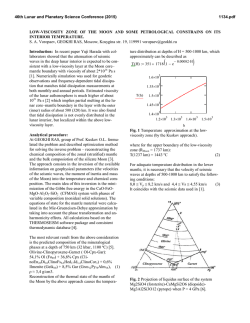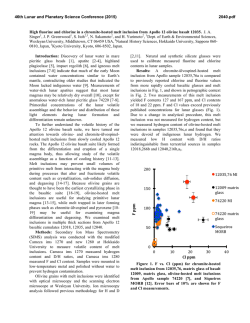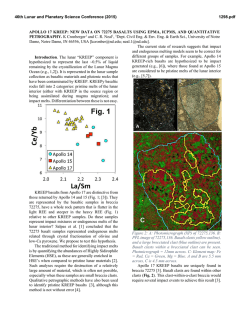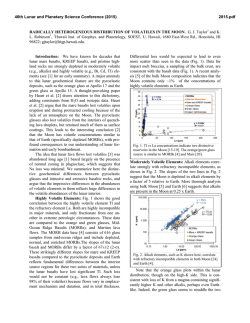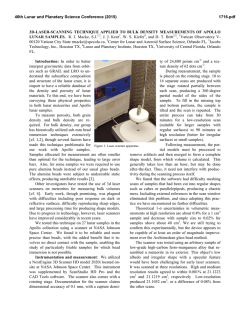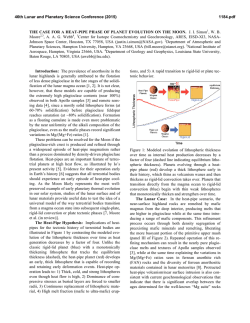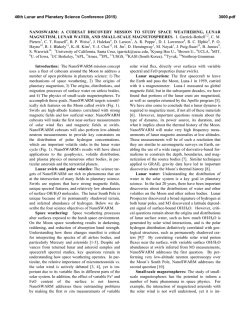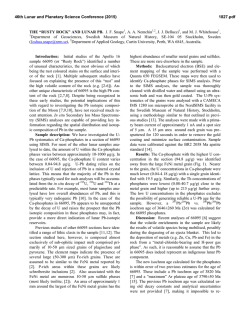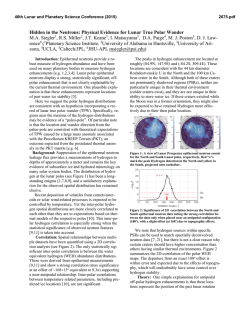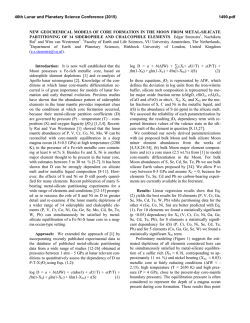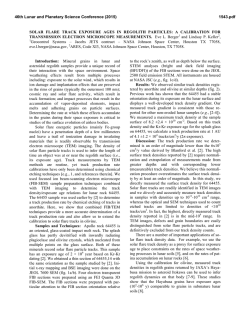
BUOYANCY DRIVEN MAGMATIC ASCENT OF MG
46th Lunar and Planetary Science Conference (2015) 1158.pdf BUOYANCY DRIVEN MAGMATIC ASCENT OF MG-SUITE PARENTAL MELTS. T.C. Prissel1, J.L. Whitten2, S.W. Parman1, and J.W. Head1. 1Department of Earth, Environmental & Planetary Sciences, Brown University, Providence, RI 02912 USA. 2Smithsonian Institution, MRC 315, PO Box 37012, Washington, DC 200137012, USA. ([email protected]) Background & Premise: The lunar highlands Mgsuite samples are predominantly comprised of coarse grained, ultramafic intrusive clasts including dunites, troctolites and norites [e.g. 1-3]. Consistent with a current lack of remotely sensed Mg-suite volcanic deposits [4], only two known lunar basaltic clasts (within samples 14305 and ALHA 81005) may be Mg-suite melts [5,6]. Thus, the current sample set along with a lack of orbital Mg-suite extrusive observations has led many to hypothesize Mg-suite petrogenesis involved parental magmas forming plutons within the lunar crust [13,7,8]. While present models adequately explain the chemistry and petrologic features of Mg-suite rocks, they do not directly address why Mg-suite parental melts did not erupt [4]. The absence of Mg-suite extrusive deposits is somewhat unexpected given that mare basalts cover approximately 18% of the lunar surface [9-12]. Morever, the mare basalts and picritic glasses are high density melts relative to the density expected for Mg-suite material [4]. What then prevented Mg-suite melts from erupting? Or, does an extrusive/volcanic equivalent of the Mg-suite exist on the lunar surface? What regions of the Moon, if any, would be conducive to Mg-suite volcanism? In order to explore these fundamental questions, we investigate buoyancy driven magmatic ascent of Mgsuite parental melts. Three theoretical Mg-suite parental magmas are considered herein. Results are compared with GRAIL data to delineate regions of the Moon where Mg-suite melts are less dense than the lunar crust (i.e. areas that would potentially allow for Mg-suite eruptions). Because Mg-suite samples are ancient igneous rocks (> 4.1 Ga) [13,14], results from this study may have implications concerning early melt transport on the Moon and the thermal evolution of the lunar crust. Mg-suite Parental Melt Compositions: Because evidence of an extrusive equivalent to the Mg-suite is lacking, any parental melt composition must be inferred from known lithologies [e.g. 7,15,16]. For example, the lunar troctolites are among the most primitive samples within the Mg-suite and thus, have often been used to constrain models of parental melt compositions [2,78,18-19]. Here, the most recent compositional estimate of [7] is taken. As the troctolites contain the most magnesian olivine amongst Mg-suite samples, we use the troctolitic melt above (Mg# ~87) to constrain the Mg# of alternative Mg-suite parental melts investigated in this study. The primitive Mg-suite dunites (72415, 72416, 72417, and 72418) are also considered in our model as is a parental melt composition pertaining to recent remote detections of Mg-spinel anorthosites, or PSA (pink spinel anorthosite). Because the dunites contain little to no feldspar and are comprised of olivine similar in composition to the lunar troctolites [e.g. 19,20], they likely represent the products of an ultramafic, plagioclaseundersaturated parental melt. PSA appears to be nominally void of mafic silicates [21,22] and has been experimentally linked to Mg-suite magmas [23]. The high Mg# interpreted for the spinel [21,24] as well as the lack of a mafic phase suggests PSA melts contain spinel and plagioclase as primary liquidus phases within an Mg-rich parent magma. Thus, we use the experimental melts produced in [23] to serve as a proxy for our PSA melt. Model: Similar to the mare eruption model of [25], buoyancy-driven magmatic ascent on the Moon is investigated, but with respect to Mg-suite parental melts [4]. Potential regions of Mg-suite eruptions are defined as the areas where the 1atm Mg-suite melt densities are less than average crustal densities. Just as [25] state however, the potential areas of eruption predicted here do not indicate volcanism has occurred. Instead, highlighted regions only imply that eruptions are possible assuming Mg-suite melts were present. We work under the assumption that current crustal densities measured by GRAIL (2325 – 2830 kg/m3) can be applied to the ancient lunar crust at the time of Mgsuite magmatism (> 4.1 Ga). Average global crustal density maps are recreated using current GRAIL data (see [26], their model 1). The data were interpolated to create a raster of average global crustal density. Regions of the crust with exposed mare basalts are not included in this analysis; any ancient extrusive deposits in these regions would be undetectable as they are likely covered by the younger mare basalt flows present. Only highland regions of the crust were considered. Melt Densities: Densities of Mg-suite parental melts are calculated using the methods of [27]. For simplicity, all compositions are assumed to be anhydrous. [28] examined the effects of dissolved water on the eruptibility of the picritic glasses, incorporating between 1000 – 5000 ppm H2O in their density calculations. Note however, the lowest estimates used in [28] appear to be a maximum for dissolved water in the lunar glasses [see 46th Lunar and Planetary Science Conference (2015) 29-30]. Regardless, the addition of ~0.10 wt.% H2O decreases the melt density by only ~10 kg/m3, a nominal effect. Densities of the Mg-suite parental melts at 1400oC (an average liquidus temperature of the very low-Ti lunar glasses, see [25]) are 2695, 2757, and 2643 kg/m3 (troctolitic, dunitic and PSA melts respectively). Conclusions & Future Work: Only a small percentage of the lunar crust bears a potential for Mg-suite eruptions (< 10% globally). An ultramafic, plagioclaseundersaturated melt appears to be most consistent with current petrogenetic models, which suggest the Mgsuite was predominantly intrusive (Fig. 1, top). Considering the troctolitic and PSA melts however, the buoyancy model indicates a few potential areas of eruption (Fig. 1, middle and bottom). The relatively lower densities of the troctolitic and PSA melts compared to the dunitic melt result in a greater total area of potential eruptive regions focused primarily within the southern highlands and SP-A. For Mg-suite volcanism to have occured in these areas, the parental magmas would need to have been present. What evidence exists suggesting Mg-suite magmas were active within or near the predicted regions of eruption? Future work includes correlating Mg-suite remote detections with proposed potential areas of eruption. We will also investigate the effects of temperature and pressure on melt densities considered here. Forthcoming models of the thermal and chemical evolution of the 1158.pdf lunar crust should consider both the predominantly intrusive history of the Mg-suite and also the potential presence of low-FeO extrusive deposits on the Moon. Acknowledgements: We would like to thank and greatly appreciate Mark Wieczorek and the GRAIL team for the gravity data used in this study. Research supported through the NASA SSERVI grant NNA14AB01A. References: [1] James O.B., 1980 11th Proc. LPSC 365-393 [2] Warren P.H. 1986 JGR, 91. D331-D343 [3] Shearer C.K., & Papike J.J., 2005 GCA. 69 No.13 3445-3461 [4] Prissel T.C. et al., 2013 LPSC 44 #3041 [5] Arai T. et al. 2006. LPSC 37 #2387. [6] Treiman, A. H. & Gross, J. 2013 MetSOC 76 #5183 [7] Longhi J. et al. 2010 GCA, 74. 784-798 [8] Elardo S.M. et al., 2011 GCA 75 11 3024-3045 [9] Head J.W. 1976 Rev. Geophys. Space Phys. 14 No.2 265-300 [10] Head J.W. & Wilson L. 1992 GCA 56 2155-2175 [11] Rutherford M.J. & Papale P. 2009 Geology 37 219-222 [12] Whitten J.L. & Head J.W. 2015 Icarus 247 150-171 [13] Nyquist L.E., and Shih C.Y. 1992 Geochim. Cosmo Acta 56:2213-2234 [14] Carlson R.W. et al., 2014 Phil. Trans. R. Soc. A 372 No.2024 [15] McCallum I.S. & Schwartz J.M. 2001 JGR 106 27969-27983 [16] Longhi J. 2003 JGR 108 5083. [17] Ryder G. 1991 GRL 18 2065-2068 [18] Hess P.C. 1994 JGR 99 19083-19093 [19] Ryder G. 1992 Proc. LPSC 22 373-380 [20] Shearer C.K. et al., 2012 2nd Conf. Lunar Highlands 9026 [21] Pieters C.M. et al. (2011) JGR, 116. [22] Dhingra D. et al. (2011) GRL, 38 [23] Prissel T.C. et al., 2014 EPSL 403 144-156 [24] Jackson C.R.M. et al., 2014 Am. Min. 99 1821-1833 [25] Wieczorek M.A. et al., (2001) EPSL 185, 71-83 [26] Wieczorek M.A. et al., 2013 Science 339 671-675 [27] Lange R.L. & Carmichael I.S.E. 1990 Rev. Min. 24 25-64 [28] Xu Y. et al., 2014 Phys. Earth Planet. Int. 229 55-60 [29] Saal A.E. et al., 2008 Nature 454 doi:10.1038/nature07047 [30] Hauri E.H. et al., 2015 EPSL 409 Fig. 1. Global average crustal density from GRAIL. Densities of each Mg-suite composition is given on each figure (troctolitic: 2695, olivine-saturated: 2757, and PSA melt: 2643 kg/m3). Black filled areas are regions predicted to allow for Mg-suite eruption. Grey areas not analyzed.
© Copyright 2025
